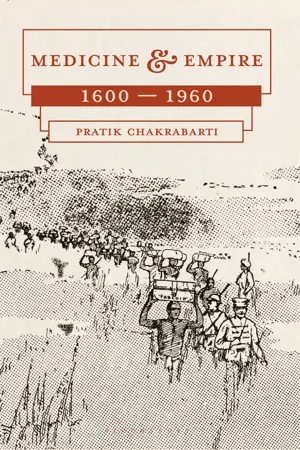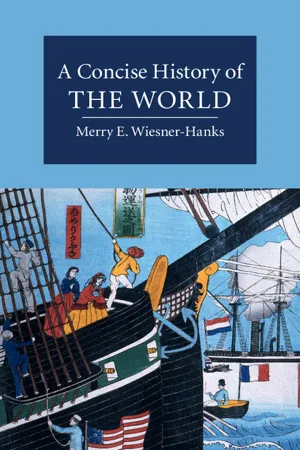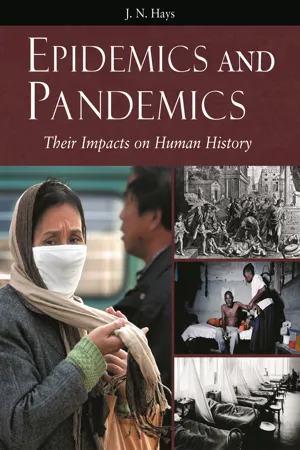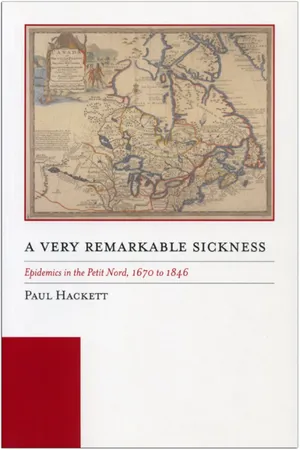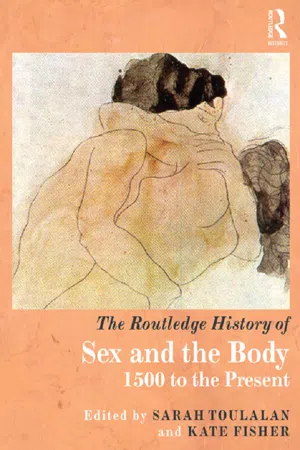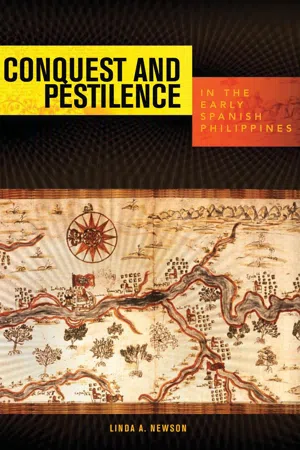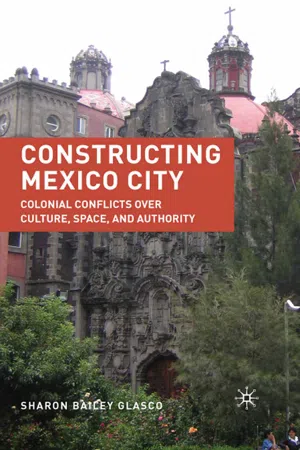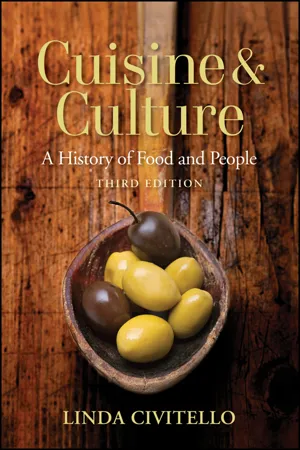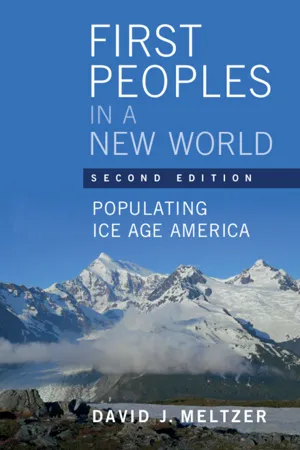History
Columbian Exchange Diseases
The Columbian Exchange Diseases refer to the transfer of infectious diseases between the Old World and the New World following the arrival of European explorers in the Americas. This exchange led to devastating consequences for the indigenous populations, as they had no immunity to diseases such as smallpox, measles, and influenza. The resulting epidemics caused significant population declines in the Americas.
Written by Perlego with AI-assistance
Related key terms
1 of 5
10 Key excerpts on "Columbian Exchange Diseases"
- eBook - PDF
Medicine and Empire
1600-1960
- Pratik Chakrabarti(Author)
- 2013(Publication Date)
- Red Globe Press(Publisher)
Following the Columbian voyages, it is estimated that up to 90 per cent of the indigenous population in certain parts of the Americas were wiped out. The mortality was most striking and drastic in the densely populated parts as disease could spread more quickly. In this chapter I will examine the transmission of disease through global migrations in four different contexts of colonial history: first, the dissemination of Old World diseases to the New World in the sixteenth century; second, the rise in mortality among Europeans and other races in the eighteenth century; third, the political and medical debates over the transmission and control of cholera from Asian colonies to Europe in the nineteenth century; and finally, the history of yellow fever as it spread across the Americas from the early days of colonialism to the twentieth century. These four different episodes reflect four different instances of colonial migration of humans and diseases. They also high-light the fact that migration was only part of this story. The social, economic and cultural consequences in the regions where these migrations occurred are equally 74 MEDICINE AND EMPIRE important. From these histories of migration and disease we learn more about the history of colonialism itself. Inherent in these histories are narratives about when disease took epidemic forms. Epidemics by their very character affect large sections of populations and communities, and spread over vast regions and different climatic and geographic zones. Thus the history of epidemics enables us to understand the wider and deeper social, economic, political and cultural histories that lead to disease and death. It also helps us to understand the diverse ways in which the same disease can affect different communities,. In this chapter I will study two processes: how imperialism led to the global spread of epidemics and how the control of epidemics became an important rationale for imperial expansion. - eBook - PDF
- Merry Wiesner-Hanks(Author)
- 2015(Publication Date)
- Cambridge University Press(Publisher)
These products were often consumed in new urban social settings and cultural institutions, where men—and a few women—shared ideas as well as commodities. Religious reforms and reinvigorations heightened spiritual zeal and created new arenas of conflict, as well as sharpening those created by rivalries over territory or resources. The early modern world was a new one of global connections, in which goods, ideas, and people—including peasants and slaves— moved and mixed, changing social and economic patterns and creating novel cultural forms. the spread of disease Prime among the disastrous effects of the Columbian Exchange was the spread of disease, which began with Columbus’ second voyage in 1493. This expedition was huge, with about 1,500 men, includ- ing adventurers, soldiers, artisans, and farmers who brought with them seeds for European crops and farm animals. This voyage set a pattern that would be followed in many other places. The ships landed on the large island of Hispaniola, which had a population between 400,000 and 600,000 engaged in farming cultivated plots. The Spanish were mostly interested in gold, and they captured, tortured, and killed the indigenous Taino in their search for precious metals. Many went back to Spain disappointed after a few weeks, and many more died of starvation, intestinal diseases from drinking 212 A new world of connections, 1500 CE–1800 CE the local water, or diseases they had brought from Europe with them, which most likely included malaria, typhus, influenza, and perhaps smallpox. Taino died even more readily from these, and from other Old World diseases against which they had no resist- ance, such as measles, mumps, diphtheria, bubonic and pneumonic plague, and scarlet fever. After a particularly virulent outbreak of smallpox throughout the Caribbean in 1518, very few Taino were left on Hispaniola, and the number of indigenous people on other islands had fallen dramatically. - eBook - ePub
Epidemics and Pandemics
Their Impacts on Human History
- Jo N. Hays(Author)
- 2005(Publication Date)
- ABC-CLIO(Publisher)
The Americas before Columbus certainly had a broad spectrum of diseases. Intestinal ailments—dysentery and diarrhea—were apparently common, as were fungal diseases. Streptococcal infections existed in America, and some form of tuberculosis (although perhaps not the pulmonary variety) was found as well. The pre-Columbian presence of malaria and yellow fever, both of which became especially important in Central America and the Caribbean, remains in dispute, as does influenza; in the latter case influenza’s many subtypes and rapid mutations make tracing its past exceptionally difficult. And American populations did harbor treponema pathogens, probably including that responsible for syphilis (see “‘French Disease’ in Sixteenth-Century Europe”). America was therefore hardly a disease-free Eden when Columbus arrived.But some important and very dangerous diseases were absent, including smallpox, measles, typhus, and plague. Some features of their epidemiologies may help our understanding of their effects when they arrived in America. Smallpox and measles both result from infection by viruses that spread from one person to another through the respiratory system; both, that is, are airborne infections and so can spread easily and quickly, especially in crowded settlements. An infected person may be a source of contagion when (in effect) he or she is actively sick; in the case of smallpox, “from just before the rash appeared until the last scab dropped off about three weeks later” (Hopkins 2002, 5). Generally, both diseases can only infect an individual once; a recovered smallpox victim is immune from another attack of smallpox, and a recovered measles victim won’t again suffer from measles. That last characteristic means that both diseases persist by finding virgin subjects, and in most of their histories they have found such subjects in one generation of children after another.The severity of smallpox and measles has varied at times and places. In recent times in the Western world measles has been thought of as a relatively mild childhood disease, more serious than chicken pox but rarely a killer. At other times and places measles has been very dangerous. In medieval Europe smallpox may have been chiefly a childhood complaint, although evidence is mixed. The varying severity of smallpox stems in part from the fact that three different species of the causative virus exist, one of them (Variola major - eBook - PDF
A Very Remarkable Sickness
Epidemics in the Petit Nord, 1670 to 1846
- Paul Hackett(Author)
- 2002(Publication Date)
- University of Manitoba Press(Publisher)
1 Old World Disease Transmission Patterns THE ISOLATION THAT HAD LONG PROTECTED THE NEW WORLD from the diseases of the Old World shattered with the coming of the Euro-peans in the late fifteenth century. Within two decades of Columbus's ar-rival on the island of Hispaniola, crowd diseases began to appear in continental North America. 1 The historical period did not begin in the Petit Nord until a century and a half later. In-between lay a long period of uncertainty during which exogenous, or external, influences, including epidemics, may have made their way to the region. Although the fate of the people of the Petit Nord during this obscure era must remain a mystery in the absence of any direct evidence, we can still examine the changing con-ditions that favoured or, conversely, would have hindered such protohistoric diffusion. In turn, this period set the stage for the centuries that followed. Mesoamerica: A Southern Disease Pool In late 1518 or early 1519, smallpox arrived at Santo Domingo, the admin-istrative centre of New Spain, situated in what is now the Dominican 22 CHAPTER ONE Republic. By 1520 this sickness had made its appearance in Mexico, ushering in a new era of disease in North America. The number of victims taken by this first epidemic is unknown, but undoubtedly the mortalities were stag-gering. 2 It was, however, only the beginning. Thereafter, Old World dis-eases were an increasingly frequent threat in Mexico, Central America, and the northern part of South America, as large numbers of susceptibles made the trip across the Atlantic. In part, these susceptibles came from the ranks of the Spanish settlers, clerics, and adventurers who sought their future in the bounty of the New World. - eBook - PDF
The Routledge History of Sex and the Body
1500 to the Present
- Sarah Toulalan, Kate Fisher, Sarah Toulalan, Kate Fisher(Authors)
- 2013(Publication Date)
- Routledge(Publisher)
Part XIII SEXUAL DISEASE 25 ‘ THE VENEREAL DISEASE ’ , 1500 – 1800 Kevin Siena Historians rely on periodization, the practice of defining certain eras as distinct from others. Like rivers that help form geographic boundaries, historians use great events to demarcate ages. The dawn of early modernity is marked by a litany of developments in the vicinity of 1500 said to terminate the middle ages: Gutenberg’s press, Columbus’ journey, Luther’s shattering of Christian unity, Copernicus’ transposition of earth and sun. After these events, we are told, the middle ages were no more. Although it is not invoked with the same gravity as these legends of textbooks, yet another event changed European life at the close of the fifteenth century: the 1494 emergence of a lethal disease that will eventually be called syphilis. For the history of sexuality it helps ring in a new age. The disease spawned one of history’s longest recorded debates, running into this its sixth century. Did it return with Columbus or was it a new strain of an existing disease? Nowadays syphilis’ origin falls to paleopathologists studying pre- and post-Columbian bones on opposite sides of the Atlantic. But for all the power of techniques like carbon dating, the jury is still out. 1 The tide of opinion has long supported the view characterized by Alfred Crosby’s phrase ‘the Columbian Exchange’, which sees Europeans and Americans trading smallpox for syphilis. 2 In these histories white sailors’ bodies shuttle microbes across the ocean introducing them to ill-prepared populations with bad con- sequences for Europe and genocidal ones for America. 3 With recent awareness of envir- onmentalism and globalization, meta-narratives on the global history of disease, in which the Columbian exchange plays a central role, have been powerful. 4 However, recent ana- lysis of pre-Columbian English skeletons with possible signs of syphilitic damage ensures that the debate continues. - Linda A. Newson(Author)
- 2009(Publication Date)
- University of Hawaii Press(Publisher)
10 C H A P T E R 2 The Role of Disease S outheast Asia is generally considered to have been part of the Eurasian dis-ease pool, with Old World diseases spreading to the islands as trading con-tacts with the mainland developed in the Christian Era. 1 Hence, the lower level of depopulation in the early colonial Philippines compared to the Americas is often attributed to its populations having acquired some immunity to Old World diseases, such as smallpox and measles, prior to Spanish arrival. However, the issue of whether or not Filipinos had acquired such immunity has not been investigated directly. Rather it is has generally been inferred from the relatively low level of de-population in the early colonial period. The issue is important because if Filipinos lacked immunity it could be argued that population decline in the early colonial period could be attributed to Old World diseases rather than other causes, such as conflict or colonial rule. This chapter will show that any immunity to acute infec-tions the Filipinos had in pre-Spanish times was very limited because the popula-tion of the Philippines was small and dispersed. But that low population density may have been a product, at least in part, of the presence of chronic infections, which took a regular toll of the population. This factor has not been considered in explaining low population densities in Southeast Asia in general, for which warfare and low fertility are usually held responsible. 2 This chapter will therefore examine what diseases were present in the Philippines when the Spanish arrived and explore their demographic implications. Some Key Concepts Critical to an understanding of the demographic impact of Old World diseases is the distinction between chronic and acute infections. 3 Chronic diseases do not kill their hosts or provoke an immune response that results in the death of the disease organisms, which means they can persist for long periods even in small populations.- eBook - ePub
Plagues Upon the Earth
Disease and the Course of Human History
- Kyle Harper(Author)
- 2021(Publication Date)
- Princeton University Press(Publisher)
86The full brunt of European disease was felt even later in the interior and west of North America. Smallpox diffused across the Great Plains from the later eighteenth century. Elizabeth Fenn has traced the forgotten western loop of the smallpox epidemic of the 1770s and 1780s; the outbreak in the backdrop of the American Revolution was an almost continent-wide event that swept across the Plains. Smallpox epidemics continued to strike into the nineteenth century, and native voices underscore the deadliness of these events and their role in white expansion. In one Kiowa legend, Uncle Saynday, a trickster who protected the Kiowa people, was roaming the prairie when he saw “a dark spot” moving toward him from the east. As Saynday approached, he saw it was a man on a horse, his face “pitted with terrible scars.” The stranger announced himself as “Smallpox.” “I come from far away, across the Eastern Ocean. I am one with the white men—they are my people as the Kiowas are yours. Sometimes I travel ahead of them, and sometimes I lurk behind.… I bring death. My breath causes children to wither like young plants in spring snow. I bring destruction. No matter how beautiful a woman is, once she has looked at me she becomes as ugly as death.” The Kiowas suffered repeated encounters with smallpox throughout the nineteenth century, and the horrifying disease winnowed their numbers.87Along the Pacific Coast, the sharpest impacts were felt in the early nineteenth century. As we will see in chapter 11 , the epidemics on the coasts of Oregon and California belong largely to Pacific history and the story of European seaborne expansion in the great ocean. Decades before the California gold rush, new diseases arrived in the lush valleys inhabited by a rich mosaic of native societies. In the 1830s malaria reached the swarms of mosquitos that awaited en masse in the moist lowlands. The mortality was “lurid.” Then came smallpox—first from Russian Alaska in 1837, then again in 1844, 1854, and 1862. Where indigenous people had been crowded into missions, the slaughter was catastrophic. And then came the crush of desperate and gold-hungry settlers, willing to finish what has been called, with due consideration, a genocide. The California gold rush in many ways completes a circle that had started when Columbus eyed the gleam of the yellow metal in the jewelry of the Taí no natives some three and a half centuries before.88 - eBook - PDF
Constructing Mexico City
Colonial Conflicts over Culture, Space, and Authority
- S. Glasco(Author)
- 2010(Publication Date)
- Palgrave Macmillan(Publisher)
C H A P T E R T H R E E In Sickness and Health: Disease, Healing, and the Urban Population One of the most significant challenges that colonial leaders in Mexico City faced, in terms of managing the city, was the presence of disease. From the time the Spanish set foot on the mainland of New Spain, epidemics of smallpox, measles, and typhus decimated indigenous populations. Epidemic outbreaks of smallpox, measles, and typhus, along with endemic diseases, such as fevers, respiratory illnesses, gas- trointestinal ailments, and skin and eye disorders plagued colonial resi- dents. Unlike other aspects of material life in the colonies, disease did not differentiate between rich and poor, young and old. Everyone was susceptible, and illness touched all individuals at some point in his or her lives. However, while disease knew no class boundaries, the poor generally had much higher mortality rates than their wealthy coun- terparts. Elite groups had the tools and material resources to avoid many of the everyday aliments that the poor suffered from, especially those connected with deficient diets (in terms of both quantity and quality of food), lack of access to potable water, and unsanitary living conditions. These same material resources often allowed them to sur- vive epidemic outbreaks as well, often through their ability to “self- quarantine” within their homes or to leave the city altogether until the crisis passed. Intertwined were disease and the larger issues of urban organiza- tion and social control. In many ways, sickness was another physical manifestation of the ills that the city suffered. Just as the “body” of the viceregal capital suffered under the “illnesses” of urban disor- der and decay, so too did the “bodies” of the city’s inhabitants suffer Constructing Mexico City 50 under the web of disease. - eBook - PDF
Cuisine and Culture
A History of Food and People
- Linda Civitello(Author)
- 2011(Publication Date)
- Wiley(Publisher)
Plagues: Megadeath No people native to the Americas had immunity to European diseases. Why not? And why didn’t they have diseases of their own, except syphilis, to give to the Europeans? In Guns, Germs, and Steel, Jared Diamond advances some theo- ries to answer these questions. One is that New World people didn’t have the livestock that Europeans did, which was where a great many of the zoonoses— animal diseases that cross over to infect humans—originated. For example, the smallpox that ravaged ancient Rome came from cows. Another is that the popu- lation of the New World was scattered and not concentrated in cities where normal human interaction would have exposed people to a variety of diseases and allowed them to develop immunities. Whatever the reason, the Time of Contact was fatal to Native Americans. In three-quarters of a century, from 1520 to 1595, there were at least 14 major epi- demics of smallpox, plague, measles, typhus, and influenza from Mexico to Pan- ama. The lowest mortality rates were more than 25 percent; the highest, 90 percent. 4 122 Food Goes Global EPIDEMICS IN CENTRAL AMERICA, 1520–1595 5 DATE DISEASE LOCATION MORTALITY 1520–1521 Smallpox Mexico, Guatemala more than 25%; 1 ⁄ 3 to 1 ⁄ 2 or more 1527 Smallpox Panama 1529 Smallpox(?) Nicaragua 1531 Bubonic or pneumonic plague Honduras, Nicaragua 1531–1532 Measles and/or smallpox Mexico 60–90% 1532 Measles Guatemala 1533 Measles Honduras, Nicaragua 1545 Typhus or pneumonic plague Guatemala “three-quarters died” 1545 Cocolitzli* Mexico 80% 1558–1562 Measles and influenza Guatemala 1576–1577 Smallpox, measles, and typhus Guatemala “many children died” 1576–1581 Cocolitzli* Mexico 45% 1587–1588 Cocolitzli* Mexico 1595 Measles Mexico *A translation for cocolitzli remains elusive. From descriptions of the disease at the time, cocolitzli seems to have been a hemorrhagic fever: blood gushing from the nose, green urine, yellow skin, black tongue. - eBook - PDF
First Peoples in a New World
Populating Ice Age America
- David J. Meltzer(Author)
- 2021(Publication Date)
- Cambridge University Press(Publisher)
So it was that deadly diseases like measles and smallpox, once fatal to both adults and children, eventually became childhood illnesses. Historic, archaeological, and (in the last few years) genomic evidence reveal infectious pathogens had reached the distant corners of Europe in early medieval times. By 1492 Europeans had been exposed to scores of pathogens for thousands of years. 33 They were occasionally devastated by spectacular epidemics (some caused by the appearance of a more virulent strain of bubonic plague), such as the Justinian pandemic (541–3 CE) and the Black Death (1347–51 CE). Yet natural selection had done its work. Despite massive die-offs, mortality rates even during the Black Death were a mere 30 percent – “mere” being a strictly relative term. 34 European popula- tions were hard hit, but emerged intact. Not so in the Americas, where neither old nor young were spared. Native Americans were so defenseless against imported diseases it was interpreted by some as divine will: “For the natives,” John Winthrop wrote in 1634, “they are neere all dead of small Poxe, so as the Lord hathe cleared our title to what we possess.” 35 Others blamed native health care: “When a nation is attacked by the smallpox,” du Pratz observed, it quickly makes great havock; for as a whole family is crowded into a small hut, which has no communications with the external air, but by a door about two feet wide and four feet high, the distemper, if it seizes one, is quickly communicated to all. The aged die in consequence of their advanced years and the bad quality of their food; and the young, if they are not strictly watched, destroy themselves, from an abhorrence of the blotches in their skin. If they can but escape from their hut, they run out and bathe themselves in the river, which is certain death in that distemper. 36 Du Pratz could not understand why otherwise quite skilled native physicians could not cope with such common ailments.
Index pages curate the most relevant extracts from our library of academic textbooks. They’ve been created using an in-house natural language model (NLM), each adding context and meaning to key research topics.
